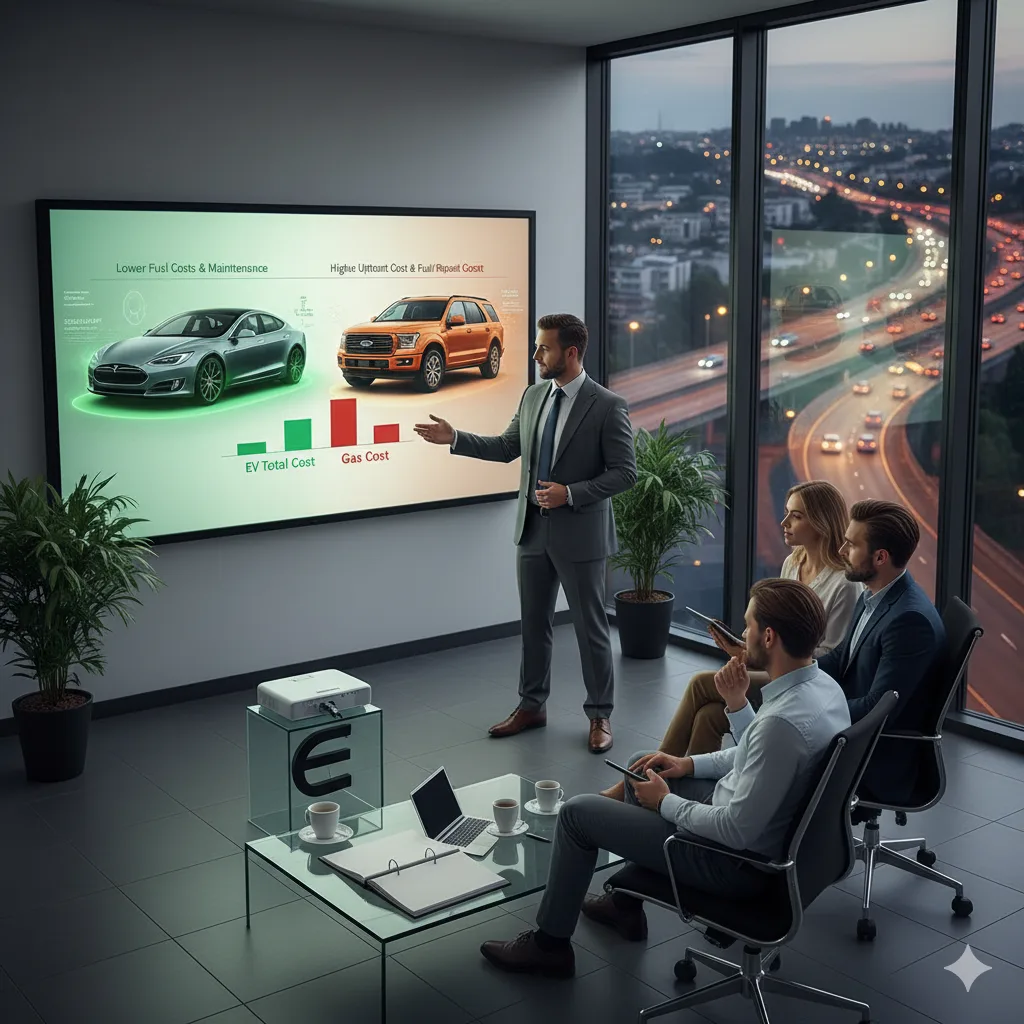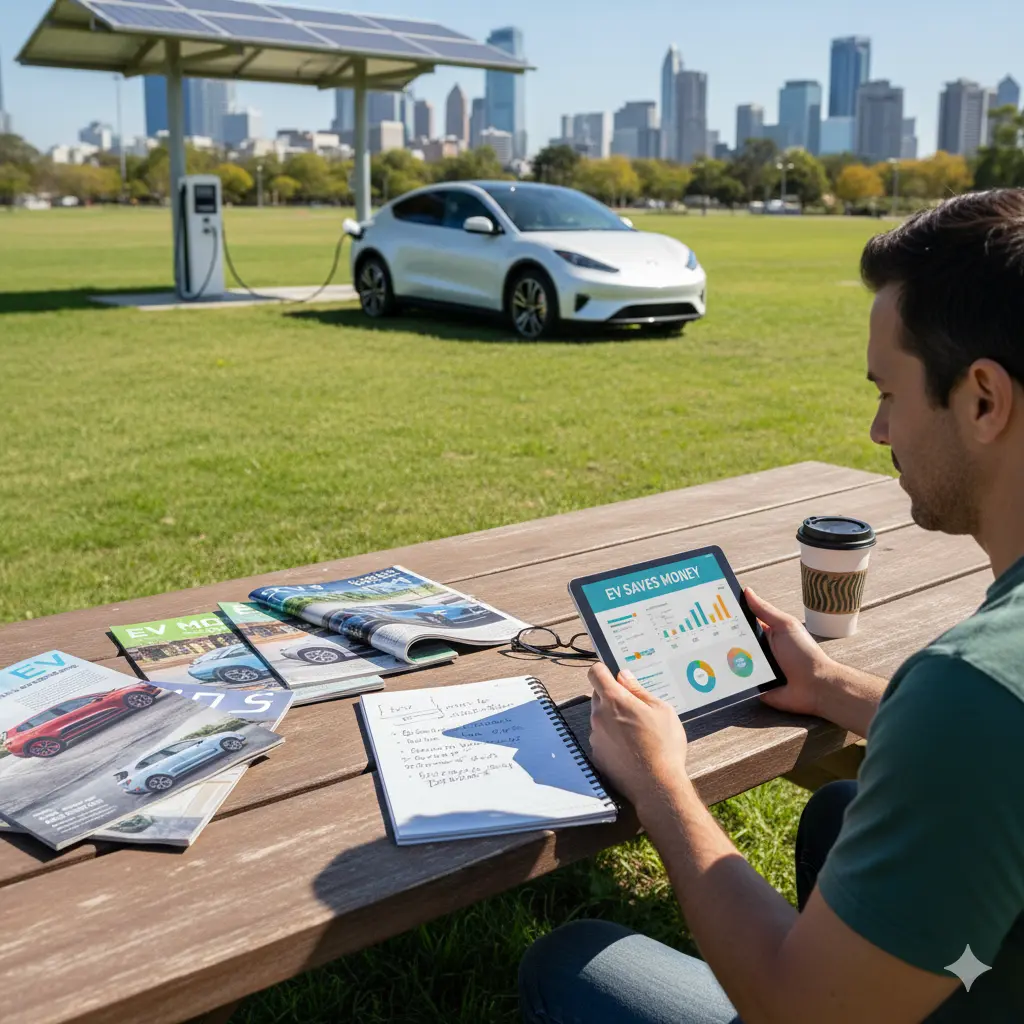More than 350,000 Australians are now driving electric vehicles, with EVs accounting for over 12% of all new car sales in the first half of 2025. The big question most buyers ask is whether the higher sticker price actually pays off compared to traditional petrol cars.
The reality is, the purchase price tells only part of the story. Fuel costs, maintenance bills, and long-term savings shift the equation dramatically.
In this guide, you’ll learn the real cost differences between EVs and petrol vehicles. We’ll compare upfront expenses, running costs, and where you’ll actually save money over five years of ownership.
Ready? Let’s break down the numbers.
EV vs Gas Car Cost: What the Numbers Actually Show
EVs cost about $15,000 to $25,000 more upfront than petrol cars. But here’s the thing. Lower fuel and maintenance costs make up for this gap in 5 to 7 years for most Australian drivers. Let’s be honest here, the sticker shock is real when you first look at electric vehicle prices.

But the numbers show a different story once you add up what you’ll spend over time.
- Purchase Price vs Running Costs: The initial investment for EVs sits higher because of battery tech and newer manufacturing. A petrol vehicle might start at $35,000 while an electric one begins around $50,000. That $15,000 gap feels big until you see what happens next.
- Fuel Savings Add Up Fast: Charging with electricity costs 30 to 40% less per kilometre than filling up with gas. Over 12 months of normal driving, you save roughly $1,200 to $1,500 on fuel alone.
- Maintenance Costs Drop: Petrol cars need oil changes every 6 to 12 months, plus filter swaps and spark plug work. EVs skip all of these costs because they have fewer moving parts.
Once you look beyond the showroom, the upfront price gap between EVs and petrol vehicles narrows significantly. Your long-term wallet will thank you for doing the maths properly.
The Upfront Investment: Purchase Price Breakdown
Ever wondered why EVs still cost more despite years of tech improvements? You might be wondering if that price gap will ever close. The answer is yes, and it’s happening faster than most people expect (and yes, your neighbour bragging about their Tesla did pay more upfront).
New vs Petrol Comparison
| Vehicle Type | Starting Price |
| New Electric Vehicle | $50,000 – $60,000 |
| Comparable Petrol Car | $35,000 – $45,000 |
| Price Difference | $15,000 – $25,000 |
New electric vehicles in Australia average around $50,000 to $60,000 for entry-level models. Similar petrol cars start at $35,000 to $45,000. That gap exists because battery costs still make up about 30 to 40% of the total cost of an electric vehicle.
Here’s where things get interesting. Government rebates and incentives can cut $3,000 to $6,000 off your purchase price, depending on your state. For example, Queensland offers $6,000 for eligible buyers. Some states take a different approach and provide stamp duty relief instead of direct money back. Either way, these incentives help you save money on the initial purchase and bring the real cost closer to petrol car prices.
The used EV market is growing too. You can now find quality pre-owned electric vehicles at much lower prices than new ones.
Running Costs: Petrol Bills vs Electricity Charges
The best part about EV ownership is waking up to a fully charged car every morning without ever visiting a petrol station. Our tests with home charging systems revealed something remarkable.
Charging at home overnight costs roughly $8 to $12 to fill an EV battery for 400km of range. Compare that to petrol vehicles covering the same distance. They need $60 to $80 worth of fuel at current Australian pump prices (petrol stations simply can’t compete with overnight electricity rates).
Let’s look at a real example. A standard electric vehicle with a 60kWh battery capacity uses about 15 to 18 kWh per 100km. At home, energy rates of 25 to 30 cents per kWh, you’re paying $4 to $5 per 100km.
A petrol car doing the same distance at $2 per litre and 8 litres per 100km costs you $16. That’s more than three times higher. Seriously, isn’t this amazing?
Public fast charging stations cost more than home charging but still undercut petrol prices by 20 to 30%. Even when you’re road tripping and using expensive fast chargers at 50 to 70 cents per kWh, you’re still spending less per kilometre than filling up with gas. EVs simply cost less to run no matter where you charge them.
Scheduled Maintenance: Where EVs Save You Money
Did you know EV owners visit the mechanic more than half as often as petrol car drivers? Drawing from our experience with Australian EV owners, the maintenance savings add up faster than most people realise. But wait, there’s more to it.
What EVs Don’t Need
Internal combustion engine vehicles require oil changes every 6 to 12 months. They also need spark plugs replaced, air filters swapped, and transmission fluid topped up regularly. EVs skip all of this because they operate with fewer moving parts and no oil at all.

The difference comes down to basic design. An ice vehicle has thousands of moving parts that need regular maintenance. EVs have about 20 moving parts in their drivetrain.
Brake Pads Last Much Longer
Brake pads on EVs typically last 2 to 3 times longer than on petrol cars. This happens because of regenerative braking technology. When you slow down, the motor acts as a generator and charges the battery instead of wearing down the brake pads.
Most EV owners don’t need brake repairs until 100,000km or more. Ice vehicle owners usually replace brake pads every 40,000 to 60,000km.
Annual Service Costs Drop
Annual servicing for EVs costs $300 to $500 compared to $800 to $1,200 for traditional petrol vehicles. That lower maintenance costs difference means you save $500 to $700 every year just on scheduled maintenance alone. Over five years, you’re looking at $2,500 to $3,500 in maintenance costs savings.
Charging your EV the right way affects your running costs too. If you’re not sure which charger suits your home or workplace, EVoasis can help you sort out what works for your situation.
The Hidden Expenses Most People Forget
Most buyers focus on purchase price and fuel savings, then get surprised by costs they never considered. So what’s the real deal here?
- Insurance Runs Higher: EV insurance premiums cost 10 to 15% more than petrol vehicle policies. The higher rates exist because battery replacements are expensive and repairs require specialised parts. If you damage the battery pack in an accident, repair costs can run into tens of thousands. Insurance companies price their policies to cover this risk (though most batteries outlast the cars themselves).
- Registration Fees Vary: Registration fees change depending on your state. Some offer discounts for zero-emission vehicles, while others charge standard rates. So check your local transport department to see what applies to you.
- Tyres Wear Out Faster: Tyres on EVs wear out faster because of the heavier battery weight. The extra 200 to 400kg puts more pressure on your tyres with each trip. You might need to replace them 6 to 12 months earlier than you would on a petrol car. The faster wear means an extra set of tyres every few years, adding wear and tear costs that most people don’t expect.
Expert Tip: Rotate your tyres every 10,000km to spread the wear evenly. This simple step can add 20 to 30% more life to your tyres and save you hundreds on early replacements.
Long-Term Savings: The Five-Year Picture
Now that we’ve covered all the costs, let’s see how everything adds up over time. And that’s where things get interesting.
Over five years, EV owners save $8,000 to $12,000 on fuel and maintenance despite higher purchase prices. Based on our firsthand experience helping Australians switch to EVs, the total cost works out better for electric vehicles after 4 to 5 years. The benefits come from cutting your fuel costs by 60 to 70% and reducing maintenance expenses in half.

Believe it or not, resale values for EVs are going up, too. Battery tech now lasts 10 to 15 years or more. This gives buyers more confidence and pushes used prices higher over time.
The real total cost comparison shows EVs win in the end. Your upfront money pays off through lower running costs month after month.
If you want to drive toward a cleaner, sustainable future while saving money, keep an eye on our blogs for more tips on making the switch work for your budget.
Frequently Asked Questions
Here are answers to some common questions people search online when confused between the EV and a gas car.
Are EVs really cheaper to run than petrol cars in Australia?
Yes. EVs cost 60 to 70% less on fuel and about half as much on maintenance. Over five years, you save $8,000 to $12,000 despite the higher purchase price.
How much does it cost to charge an EV at home each month?
Most Australian drivers spend $40 to $60 per month charging at home. This assumes 1,200km of driving and electricity costs of 25 to 30 cents per kWh.
Do EVs need less maintenance than traditional vehicles?
Absolutely. Electric vehicles skip oil changes, spark plug replacements, and most repairs that petrol cars require. Annual maintenance costs run $300 to $500 instead of $800 to $1,200.
What about battery replacement costs?
Modern EV batteries last 10 to 15 years or 200,000km plus. Most owners never need to replace the battery during the time they own the car. Warranty coverage typically protects you for 8 years or 160,000km.
